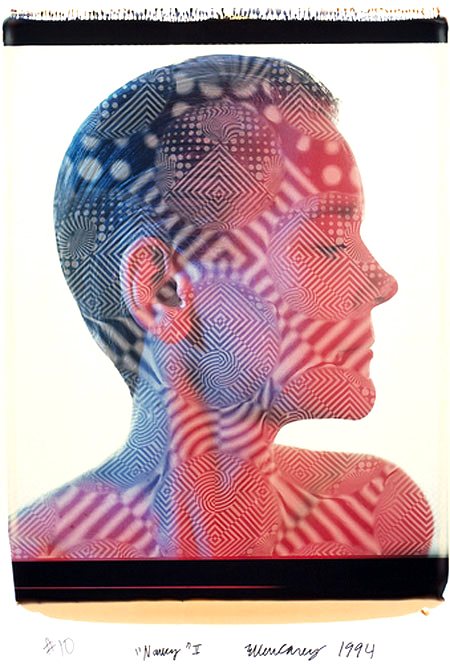In Hamlet’s Shadow
The Polaroid Years: Instant Photography and Experimentation
Delmonico-Prestel Press
2013
Essay by Ellen Carey
Mary-Kay Lombino, Exhibition Curator and Author
Frances Lehman Loeb Art Center, Vassar College
View Book on Amazon
Ellen Carey, Polaroid 20 x 24 Portrait Series (Nancy)
1994
––
Ellen Carey, My Sparkling Self
––
Ellen Carey, Pull with Black Filigree
––
The prescient Polaroid slogan See What Develops could be a metaphor for my history with this instant photographic technology. What an invention! My love for all things Polaroid was equally instant – l‘amour fou — crazy, madly, wildly in love as “seen” at first sight. It all began in the halcyon days of the 1970s, where Polaroid’s “point and shoot” met my experiments in photography and art: an ideal fit, if ever there was one. It paralleled the cultural sea changes of that time in feminism, war, politics, music. And where was photography? On the edge, ready for change: for Polaroid, in other words, the shape shifter, an agent of revolution in creative, visual thinking.
This love affair, decades long now, began with Polaroid cameras. First came the sleek, compact, minimal SX-70: an image popped out and developed before one’s eyes. Seeing my picture unfold in seconds — beautiful, small, square — framed my ideas in color. Next came the Super-Shooterfor a one-step, peel-away process. My Sparkling Self echoed the joy of my newly forged, creative partnership with Polaroid, asking: “Why not stack them up, extend the ‘frame’, add glitter too?”
My biggest love was yet to come. I grew bolder with the large format Polaroid 20 x 24 camera. Risk and chance formed a pas-de-deux of experimental abandon. As the world moved toward the 21st century, questions of identity — “Who am I? and “What is the self?” — seemed as natural for a young artist as standing in Hamlet’s shadow. Pushing boundaries led to the innovations in my Self-Portrait series of the 1980s. Sometimes, someone like Nancy Grover, would ask: “Would you do my portrait?” I loved her and Polaroid saying: “Yes!”
As I moved freely through genres and themes, a trajectory from representation toward abstraction propelled me in the 1990s to focus on light and color. These two elements were my subject matter, photographed up close and personal for more exposure. It was in this context, in 1996, that I began my Pull series, which produced a radically different kind of document. These minimal, abstract compositions found a parallel (or photographic counterpoint) in Polaroid and process. With each Pull, the visual impact was doubled by introducing a new form, the parabola, as a black conical loop, never before seen in photography, instant or otherwise. See what developed?!
Abstraction in photography and lens-based art presents a contradiction in terms, and minimalism in that context is a further oxymoron. Although abstraction was well developed in the 20th century in other art movements — Abstract Expressionism, Minimalism, and Conceptual Art — abstraction as a concept in photography is still evolving, even in 2012. Indeed, its very monumentality, Pull XL, made with the Polaroid 40 x 80 camera, matchs the gigantic scale and colossal size of my ideas of photography as art.
It is here, in the early stages of modern and contemporary art with roots in photography, that my work now has a context, and within practices largely based in America. With a full awareness of this legacy, these avant-garde tenets forefronted my umbrella concept and artistic practice in Polaroid, now known as Photography Degree Zero.
Ellen Carey
May 29, 2012



